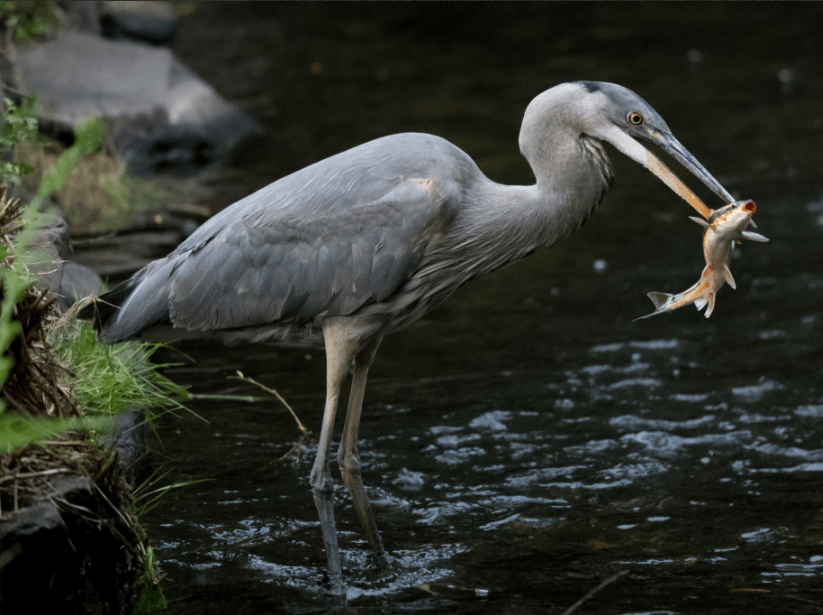That Other, Other, Other, Other Northwest Spring Spawning Run
As spring Chinook swim up rivers elsewhere in the Northwest, another local species you may not have heard of is skinnying into Lake Washington tributaries on its own spawning run.
Peamouth chub are being spotted in Juanita Creek and other streams draining into the big metro lake as schools make their quick trip to lay and fertilize “gazillions” of eggs.

District fisheries biologist Aaron Bosworth says he’s getting reports of a relatively “good” run of the red-, gold- and grey-striped fish also known as Northwestern dace and redmouth suckers.
“Good to know that some native fish species are able to make a living in Lake Washington!” he emailed.

We had actually been discussing the beautiful 15- to 16-inch rainbow trout my youngest son caught out of the tiny little local lake on yesterday’s Washington fishing reopener – an unexpected holdover – when Bosworth mentioned the minnow family member.
Frankly, despite having lived in the Seattle area for all of my almost five decades and having more than a passing interest in our various fishes — read: how to catch and cook them; their lifecycles; habitat needs and challenges; predation and management issues; etc., etc., etc. — I had never heard of the spawning run of peamouth chub.
I guess I assumed that somehow … somewhere … peamouths just managed to replicate themselves.
Indeed, I’m guessing it may be like that for many of us fishermen.
“Limited details about peamouth life history and behavior are known, in large part because they are not a popular sport fish; although they reportedly have a ‘good flavor,’ they are very bony,” reads a 2011 report from the City of Bellevue’s Utility Department.
(A 2017 49-page WDFW report on the nearshore warmwater species of Lake Washington mentions them all of three times, though notes the species along with northern pikeminnow and largescale sucker comprised 50.1 percent of the surveyed biomass.)
The bustling burg on the east side of Lake Washington began taking an interest in the species when municipal phones started ringing in the late 1990s and early 2000s as residents reported spotting small fish in city streams.
But even as quickly as city staffers got to the scene, there was often nothing left to see.
Compared to the relatively long spawning run of spring Chinook – which begins as early as March and extends into August for those migrating up Columbia Basin rivers – peamouth are veritable lightning bolts.
“During spawning events, the number of peamouth would increase within days or hours from less than ten fish to hundreds of fish, then quickly diminish until all fish returned to Lake Washington,” reads the Bellevue writeup.


The report was informed by volunteers dubbed the “Peamouth Patrol” who watched several streams over several years. A city webpage details more about the fish, including that they live for eight years on average, and another aims a webcam at Kelsey Creek, a hotbed for chubs.
Even if schools of peamouth look not unlike the hordes of smelt that swam up the Cowlitz back in February, they’re more like salmon in that they spawn in shallow riffles rather than broadcast their eggs and milt to drift in the current. As you’d imagine, the eggs are tiny, just 4mm.
Individual streams see multiple runs which can leave “the bottom coated in a layer of yellow or light brown eggs,” states the city report.
As for what triggers their speedy spawn, good question. It seems they prefer midspring but Bellevue biologists couldn’t say for sure whether it was correlated with warming lake and/or stream temperatures, or stream flows, or what.
“Other conditions that may affect peamouth spawning include barometric pressure, moon phases, or night-time light levels,” they speculated.
Whatever, the case, they’re in the mood now apparently.
“We don’t know for sure, but I think they probably spawn in all the tributaries,” says Bosworth, the WDFW biologist. “In the ones we hear about, they migrate in and spawn in huge congregations this time of year.”
We live in the upper watershed of one of those tribs, Thornton Creek, on the northwest side of Lake Washington, where we’ve had a rain garden installed to help filter street runoff that eventually drains into the stream.
Honestly, that was in hopes that coho and Chinook would eventually again run upstream, but cleaner water benefits other aquatic species in the meanwhile.
Certainly blue herons, raccoons and other hungry critters must appreciate the spring pulse of fresh fish flesh packed into small streams.
Recent years have seen increased scrutiny of Lake Washington’s fish community as salmon runs have declined, with some listed under the Endangered Species Act. A study Bosworth ran last year suggested yellow perch and rock bass gang up on outmigrating Chinook smolts in the waters just off Gasworks Park.
It’s possible that the large mass of peamouth chub in the lake present some impact – if not also opportunity for — salmonids.
“Juvenile and adult peamouth may compete with salmon for similar food; the former eat zooplankton, and the latter eat similar invertebrates as do salmon. Young peamouth may be a salmon food source, and they may be eaten by other predators that eat small salmon,” reads the Bellevue report.
Hard to say whether their population is increasing or what, but I find it’s always interesting to learn about other members of the Northwest fish world.
Even those I don’t chew on, which is how this whole thing began, with an email to a biologist about rainbow trout.

